cooling VOLVO 850 1996 Owners Manual
[x] Cancel search | Manufacturer: VOLVO, Model Year: 1996, Model line: 850, Model: VOLVO 850 1996Pages: 265, PDF Size: 4.57 MB
Page 8 of 265

1996 Volvo 850
Brake fluid warning light
If the light comes on while driving or braking, this indicates that the \
brake fluid level is too low.
Stop immediately, open the hood and check the brake fluid level in the r\
eservoir (see section "Engine compartment" for reservoir
position)!
Canadian models are equipped with this warning light:
WARNING! If the level is below the MIN mark in either section of the res\
ervoir: DO NOT DRIVE. Tow the car to a Volvo
retailer and have the brake system checked and any leakage repaired.
pg. 1:5 Warning lights
If the TRACS (TRaction Control System) is manually disengaged with the\
switch on the dashboard, the warning light will come
on. This will also come on to indicate a TRAC's malfunction, and when th\
e brakes overheat, although it goes out again at the
normal temperature level. If the lamp remains on, the system should be c\
hecked by an authorized Volvo retailer. This lamp
should not be confused with the ON/OFF indicator lamp above the switch. \
See page 1:9 for additional information.
Anti-lock Brake System (ABS)
If the warning lamp lights up there is a malfunction of the ABS system (\
the standard braking system will however function). The
vehicle should be driven to a Volvo retailer for inspection.
See page 4:16 for additional information.
Canadian models are equipped with this warning light:
Coolant level sensor
If the light comes on while driving, the coolant level is low. The coola\
nt level in the expansion tank should be checked
immediately and topped off if necessary. The cooling system should be in\
spected by an authorized Volvo retailer.
Mode "W" engaged
The lamp will light up when the Winter/Wet mode is engaged or if gears "\
3" or "L" are selected.
If the warning lamp begins to flash , this means that there is a fault i\
n the automatic gearbox.
Contact your Volvo retailer.
Supplemental Restraint System (SRS)
If the light comes on (or stays on after the vehicle has started), the\
SRS diagnostic system has detected a fault. Drive to an
file:///K|/ownersdocs/1996/1996_850/96850_101.htm (6 of 7)12/30/2006 9\
:58:55 AMClassic Cars & Cycles www.ClassicCycles.org
Page 34 of 265
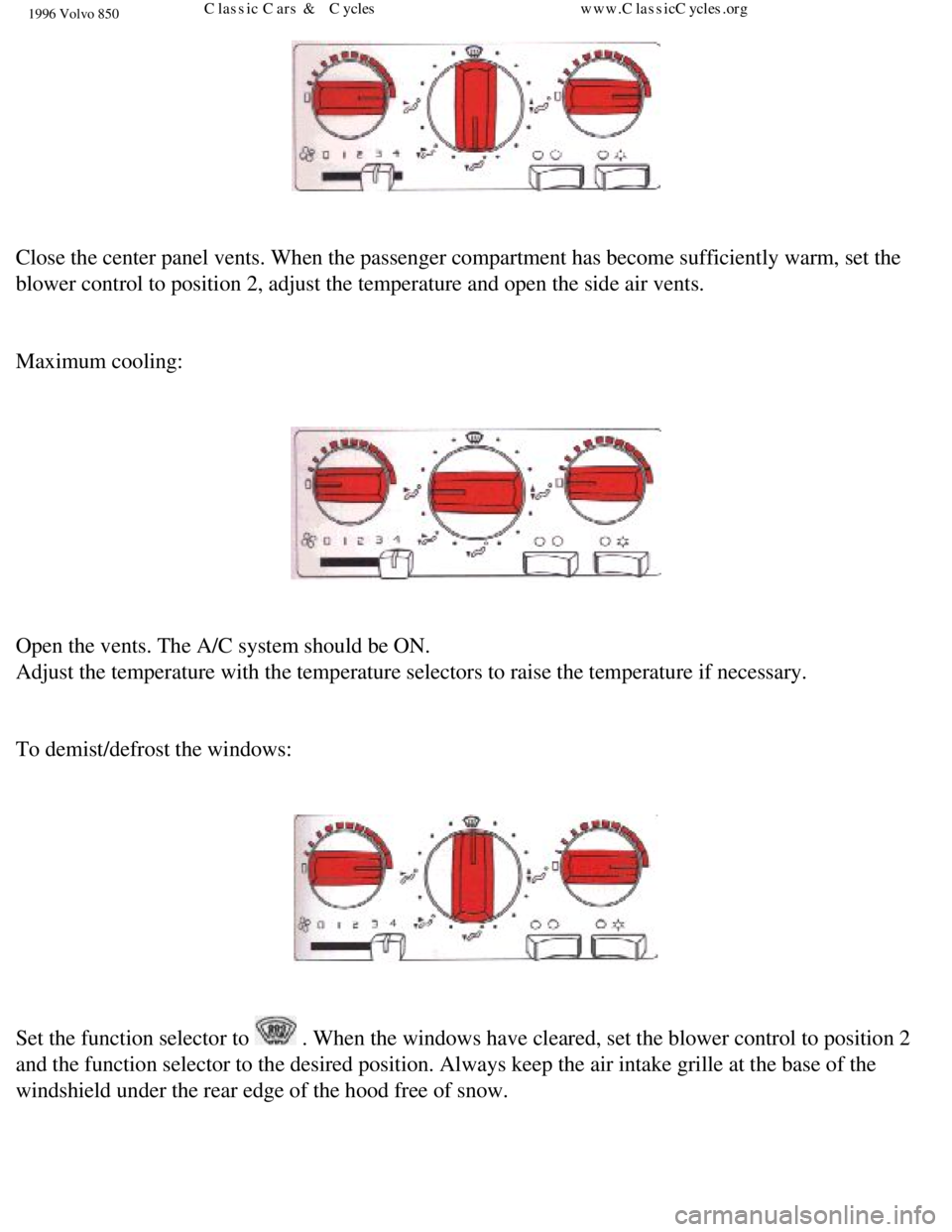
1996 Volvo 850
Close the center panel vents. When the passenger compartment has become \
sufficiently warm, set the
blower control to position 2, adjust the temperature and open the side a\
ir vents.
Maximum cooling:
Open the vents. The A/C system should be ON.
Adjust the temperature with the temperature selectors to raise the tempe\
rature if necessary.
To demist/defrost the windows:
Set the function selector to
. When the windows have cleared, set the blower control to position 2
and the function selector to the desired position. Always keep the air i\
ntake grille at the base of the
windshield under the rear edge of the hood free of snow.
file:///K|/ownersdocs/1996/1996_850/96850_119.htm (4 of 10)12/30/2006 \
9:59:03 AMClassic Cars & Cycles www.ClassicCycles.org
Page 36 of 265
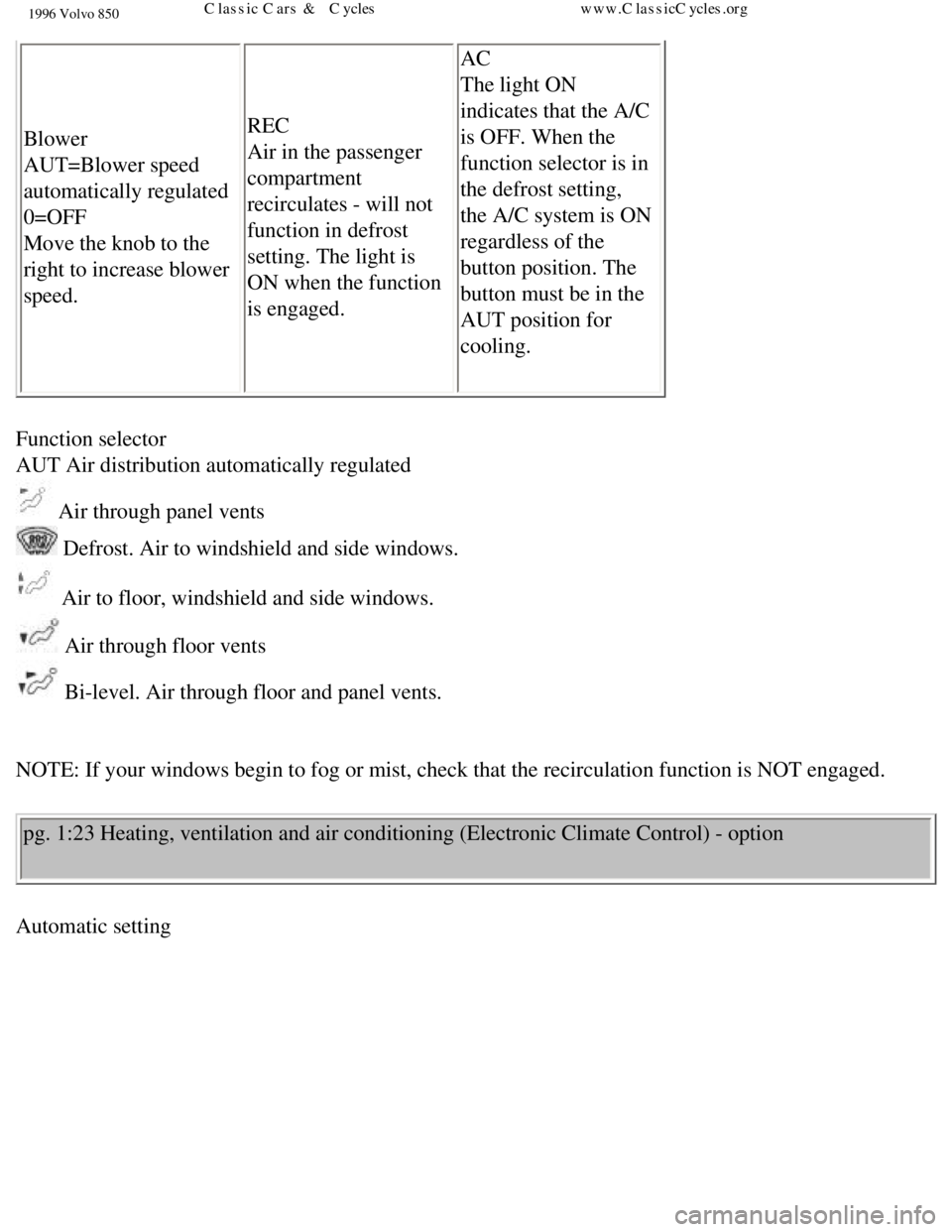
1996 Volvo 850
Blower
AUT=Blower speed
automatically regulated
0=OFF
Move the knob to the
right to increase blower
speed. REC
Air in the passenger
compartment
recirculates - will not
function in defrost
setting. The light is
ON when the function
is engaged. AC
The light ON
indicates that the A/C
is OFF. When the
function selector is in
the defrost setting,
the A/C system is ON
regardless of the
button position. The
button must be in the
AUT position for
cooling.
Function selector
AUT Air distribution automatically regulated
Air through panel vents
Defrost. Air to windshield and side windows.
Air to floor, windshield and side windows.
Air through floor vents
Bi-level. Air through floor and panel vents.
NOTE: If your windows begin to fog or mist, check that the recirculation\
function is NOT engaged.
pg. 1:23 Heating, ventilation and air conditioning (Electronic Climate \
Control) - option
Automatic setting
file:///K|/ownersdocs/1996/1996_850/96850_119.htm (6 of 10)12/30/2006 \
9:59:03 AMClassic Cars & Cycles www.ClassicCycles.org
Page 37 of 265
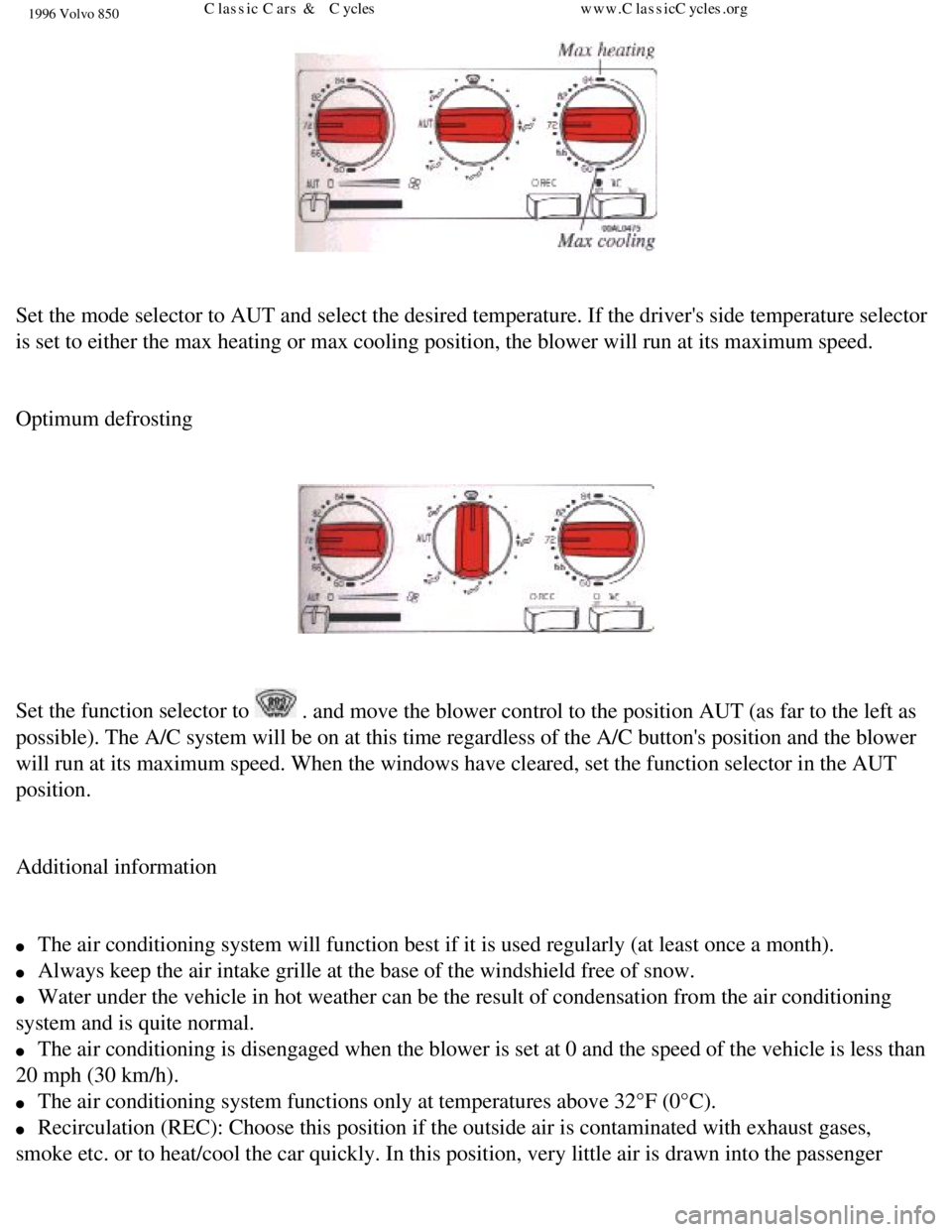
1996 Volvo 850
Set the mode selector to AUT and select the desired temperature. If the \
driver's side temperature selector
is set to either the max heating or max cooling position, the blower wil\
l run at its maximum speed.
Optimum defrosting
Set the function selector to
. and move the blower control to the position AUT (as far to the left \
as
possible). The A/C system will be on at this time regardless of the A/C\
button's position and the blower
will run at its maximum speed. When the windows have cleared, set the fu\
nction selector in the AUT
position.
Additional information
l The air conditioning system will function best if it is used regularly (\
at least once a month).
l Always keep the air intake grille at the base of the windshield free of \
snow.
l Water under the vehicle in hot weather can be the result of condensation\
from the air conditioning
system and is quite normal.
l The air conditioning is disengaged when the blower is set at 0 and the s\
peed of the vehicle is less than
20 mph (30 km/h).
l The air conditioning system functions only at temperatures above 32°F\
(0°C).
l Recirculation (REC): Choose this position if the outside air is contam\
inated with exhaust gases,
smoke etc. or to heat/cool the car quickly. In this position, very littl\
e air is drawn into the passenger
file:///K|/ownersdocs/1996/1996_850/96850_119.htm (7 of 10)12/30/2006 \
9:59:03 AMClassic Cars & Cycles www.ClassicCycles.org
Page 173 of 265
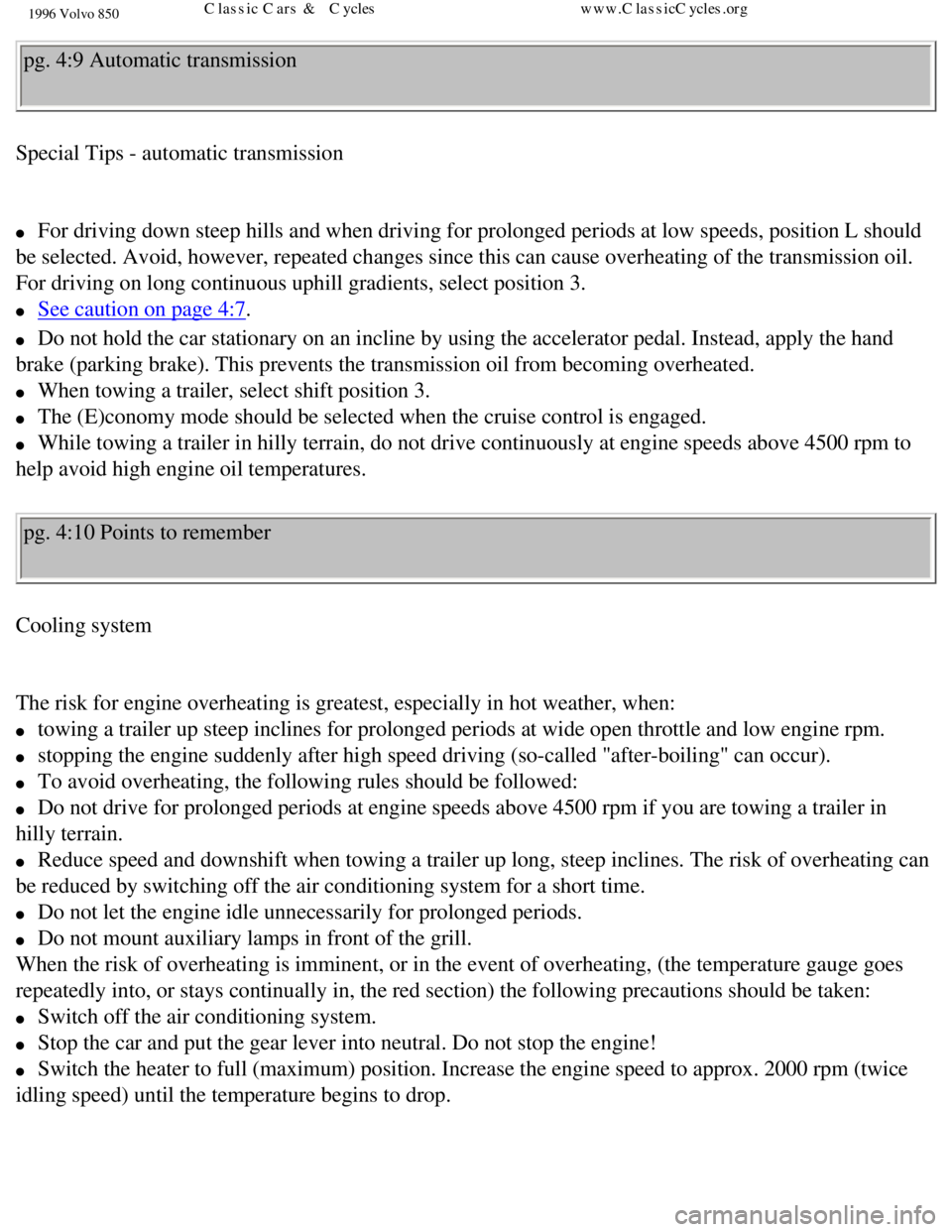
1996 Volvo 850
pg. 4:9 Automatic transmission
Special Tips - automatic transmission
l For driving down steep hills and when driving for prolonged periods at l\
ow speeds, position L should
be selected. Avoid, however, repeated changes since this can cause overh\
eating of the transmission oil.
For driving on long continuous uphill gradients, select position 3.
l See caution on page 4:7.
l Do not hold the car stationary on an incline by using the accelerator pe\
dal. Instead, apply the hand
brake (parking brake). This prevents the transmission oil from becomin\
g overheated.
l When towing a trailer, select shift position 3.
l The (E)conomy mode should be selected when the cruise control is engag\
ed.
l While towing a trailer in hilly terrain, do not drive continuously at en\
gine speeds above 4500 rpm to
help avoid high engine oil temperatures.
pg. 4:10 Points to remember
Cooling system
The risk for engine overheating is greatest, especially in hot weather, \
when:
l towing a trailer up steep inclines for prolonged periods at wide open th\
rottle and low engine rpm.
l stopping the engine suddenly after high speed driving (so-called "after\
-boiling" can occur).
l To avoid overheating, the following rules should be followed:
l Do not drive for prolonged periods at engine speeds above 4500 rpm if yo\
u are towing a trailer in
hilly terrain.
l Reduce speed and downshift when towing a trailer up long, steep inclines\
. The risk of overheating can
be reduced by switching off the air conditioning system for a short time\
.
l Do not let the engine idle unnecessarily for prolonged periods.
l Do not mount auxiliary lamps in front of the grill.
When the risk of overheating is imminent, or in the event of overheating\
, (the temperature gauge goes
repeatedly into, or stays continually in, the red section) the followin\
g precautions should be taken:
l Switch off the air conditioning system.
l Stop the car and put the gear lever into neutral. Do not stop the engine\
!
l Switch the heater to full (maximum) position. Increase the engine spee\
d to approx. 2000 rpm (twice
idling speed) until the temperature begins to drop.
file:///K|/ownersdocs/1996/1996_850/96850_406.htm (7 of 10)12/30/2006 \
9:59:34 AMClassic Cars & Cycles www.ClassicCycles.org
Page 182 of 265

1996 Volvo 850
Brake circuit malfunction
If one of the brake circuits should malfunction, the red warning light w\
ill come on, the pedal stroke
increases slightly, the pedal feels softer and extra pressure is require\
d for normal braking. If the light
comes on while driving or braking, stop immediately and check the brake \
fluid level in the reservoir.
WARNING! If the fluid level is below the MIN mark in either section of t\
he reservoir: DO NOT
DRIVE. Tow the car to a Volvo retailer and have the brake system checked\
and repaired.
Moisture on brake discs and brake pads affects braking.
Driving in rain and slush or passing through an automatic car wash can c\
ause water to collect on the
brake discs and pads. This will cause a delay in braking effect when the\
pedal is depressed. To avoid
such a delay when the brakes are needed, depress the pedal occasionally \
when driving through rain,
slush etc. This will remove the water from the brakes. Check that brake \
application feels normal! This
should also be done after washing or starting in very damp weather.
Severe strain on the brake system
The brakes will be subject to severe strain when driving in mountains or\
hilly areas or towing. The speed
is usually low which means that the cooling of the brakes is less effici\
ent than when driving on level
roads. To reduce the strain on the brakes it is advisable not to use the\
brakes excessively. Instead, shift
into a lower gear, position 3 or in some cases, L(automatic transmissio\
n) and let the engine help with the
braking. Do not forget that, if you are towing a trailer, the brakes wil\
l be subjected to greater load than is
normal.
If the brake power-assist does function
The power assist to the brakes functions only when the engine is running\
. When the car is moving
without the engine running, the brake pedal pressure required to stop th\
e car is increased by 3-4 times
and the brake pedal feels stiff.
file:///K|/ownersdocs/1996/1996_850/96850_412.htm (6 of 10)12/30/2006 \
9:59:35 AMClassic Cars & Cycles www.ClassicCycles.org
Page 188 of 265

1996 Volvo 850
NOTE: When storing wheel/tire assemblies (e.g. winter tires and wheels)\
, either stand the assemblies
upright or suspend them off the ground. Laying wheel/tire assemblies on \
their sides for prolonged
periods can cause wheel and/or tire damage.
Wear indicator
The tires have a so-called "wear indicator" in the form of a number of n\
arrow strips running across or
parallel to the tread. When approx. 1/16" (1.6 mm) is left on the trea\
d, these strips show up and indicate
that the tire should be replaced.
Tires with less than 1/16" (1.6 mm) tread have a very poor grip in rai\
n or snow.
When replacing worn tires, it is recommended that the tire be identical \
in type (radial) and size as the
one being replaced. Using a tire of the same make (manufacturer) will \
prevent alteration of the driving
characteristics of the vehicle.
To improve tire economy:
l Maintain correct tire pressure.
l Drive smoothly: avoid fast starts, hard braking and tire screeching.
l Tire wear increases with speed.
l Do not change wheel location unless necessary.
l Correct front wheel alignment is very important.
l Unbalanced wheels impair tire economy and driving comfort.
l If the wheels are rotated, they should be kept on the same side of the c\
ar so that they revolve in the
same direction as prior to rotation.
l Hitting curbs or potholes can damage the tires and/or wheels permanently\
.
Flat spots
All tires become warm during use. After cooling, when the vehicle is par\
ked, the tires have a tendency to
distort slightly, forming flat spots. These flat spots can cause vibrati\
ons similar to the vibrations caused
by imbalanced wheels. They do, however, disappear when the tire warms up\
. The degree to which the
flat spots form depends on the type of cord used in the tire. Remember t\
hat, in cold weather, it takes
longer for the tire to warm up and consequently longer for the flat spot\
to disappear.
file:///K|/ownersdocs/1996/1996_850/96850_501.htm (2 of 5)12/30/2006 9\
:59:37 AMClassic Cars & Cycles www.ClassicCycles.org
Page 244 of 265
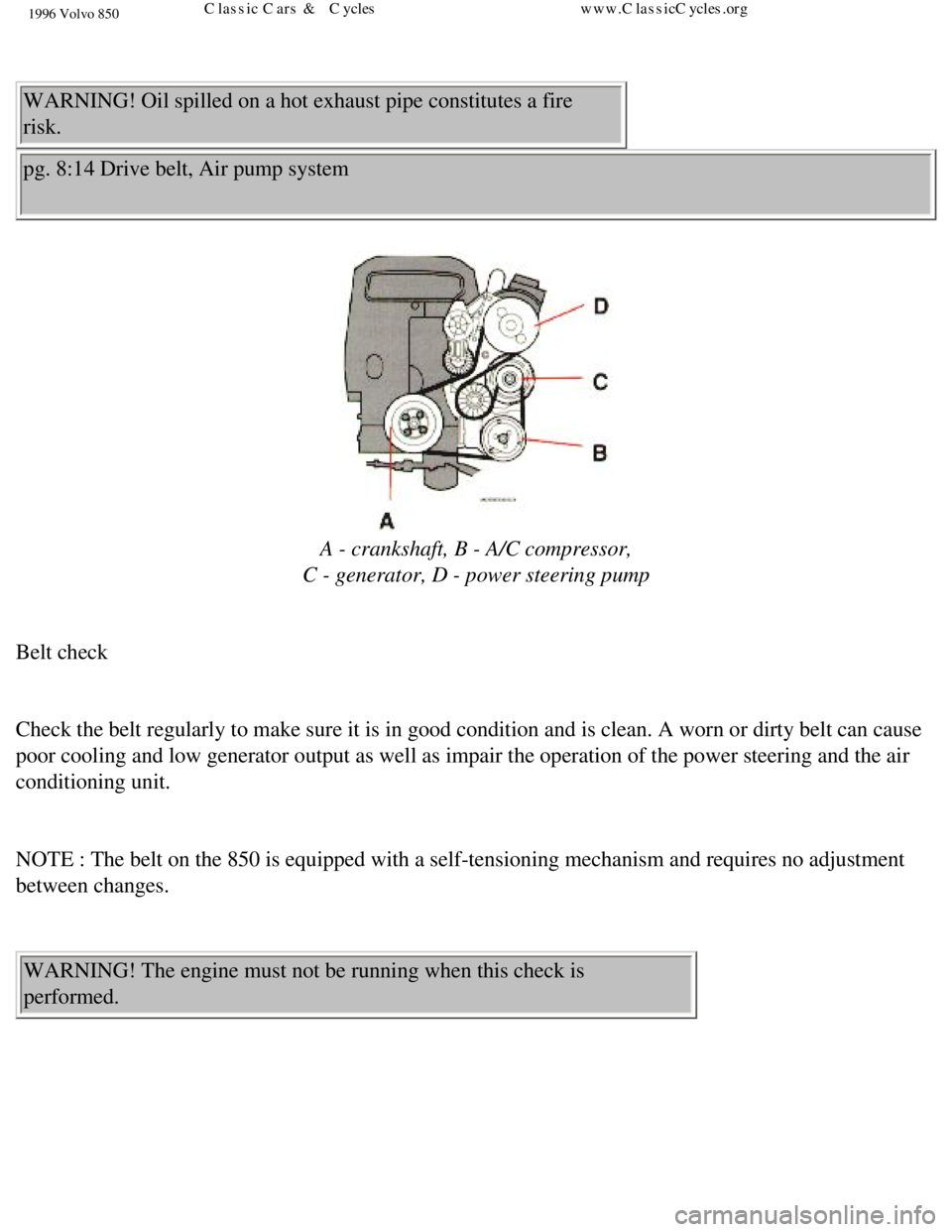
1996 Volvo 850
WARNING! Oil spilled on a hot exhaust pipe constitutes a fire
risk.
pg. 8:14 Drive belt, Air pump system
A - crankshaft, B - A/C compressor,
C - generator, D - power steering pump
Belt check
Check the belt regularly to make sure it is in good condition and is cle\
an. A worn or dirty belt can cause
poor cooling and low generator output as well as impair the operation of\
the power steering and the air
conditioning unit.
NOTE : The belt on the 850 is equipped with a self-tensioning mechanism \
and requires no adjustment
between changes.
WARNING! The engine must not be running when this check is
performed.
file:///K|/ownersdocs/1996/1996_850/96850_813.htm (2 of 7)12/30/2006 9\
:59:53 AMClassic Cars & Cycles www.ClassicCycles.org
Page 246 of 265
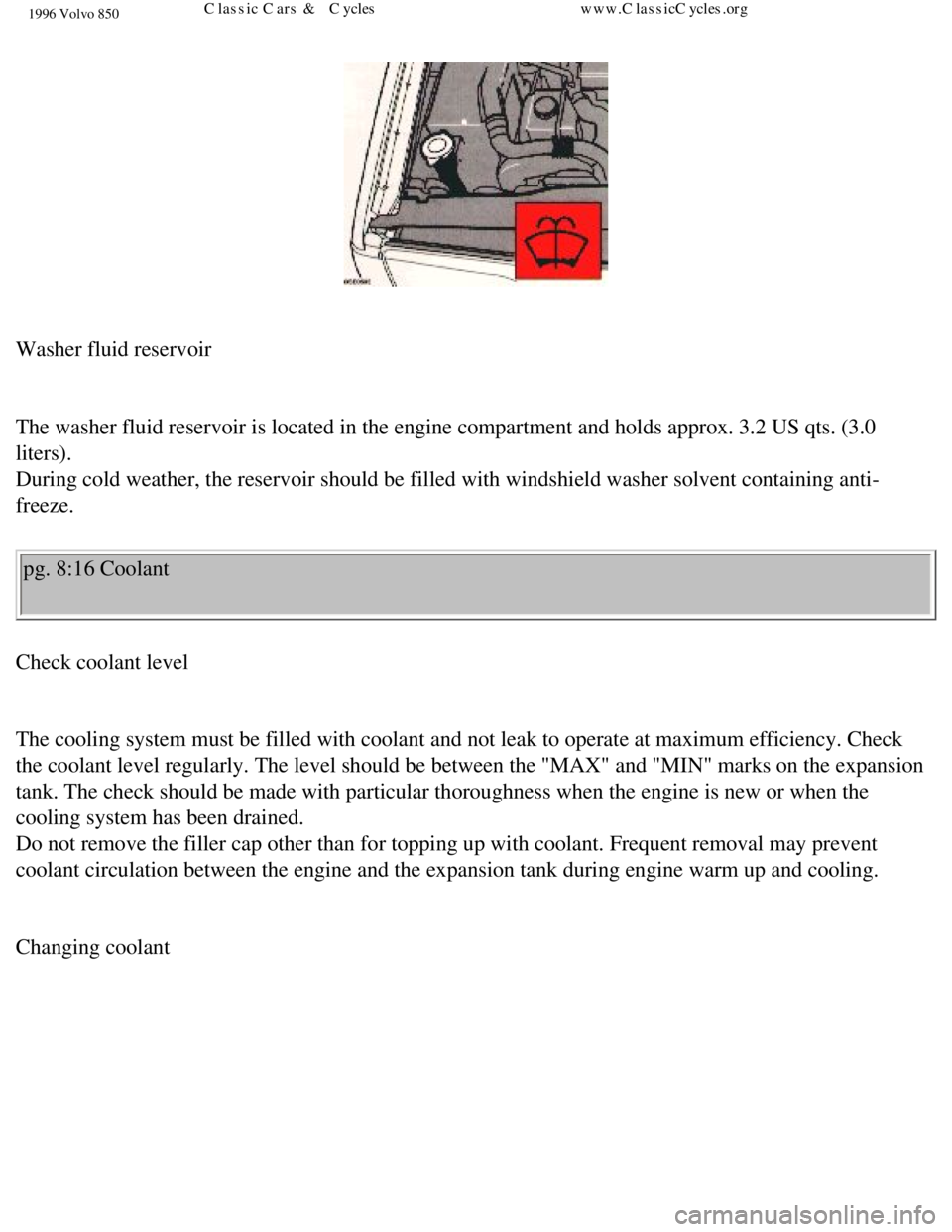
1996 Volvo 850
Washer fluid reservoir
The washer fluid reservoir is located in the engine compartment and hold\
s approx. 3.2 US qts. (3.0
liters).
During cold weather, the reservoir should be filled with windshield wash\
er solvent containing anti-
freeze. pg. 8:16 Coolant
Check coolant level
The cooling system must be filled with coolant and not leak to operate a\
t maximum efficiency. Check
the coolant level regularly. The level should be between the "MAX" and "\
MIN" marks on the expansion
tank. The check should be made with particular thoroughness when the eng\
ine is new or when the
cooling system has been drained.
Do not remove the filler cap other than for topping up with coolant. Fre\
quent removal may prevent
coolant circulation between the engine and the expansion tank during eng\
ine warm up and cooling.
Changing coolant
file:///K|/ownersdocs/1996/1996_850/96850_813.htm (4 of 7)12/30/2006 9\
:59:53 AMClassic Cars & Cycles www.ClassicCycles.org
Page 247 of 265
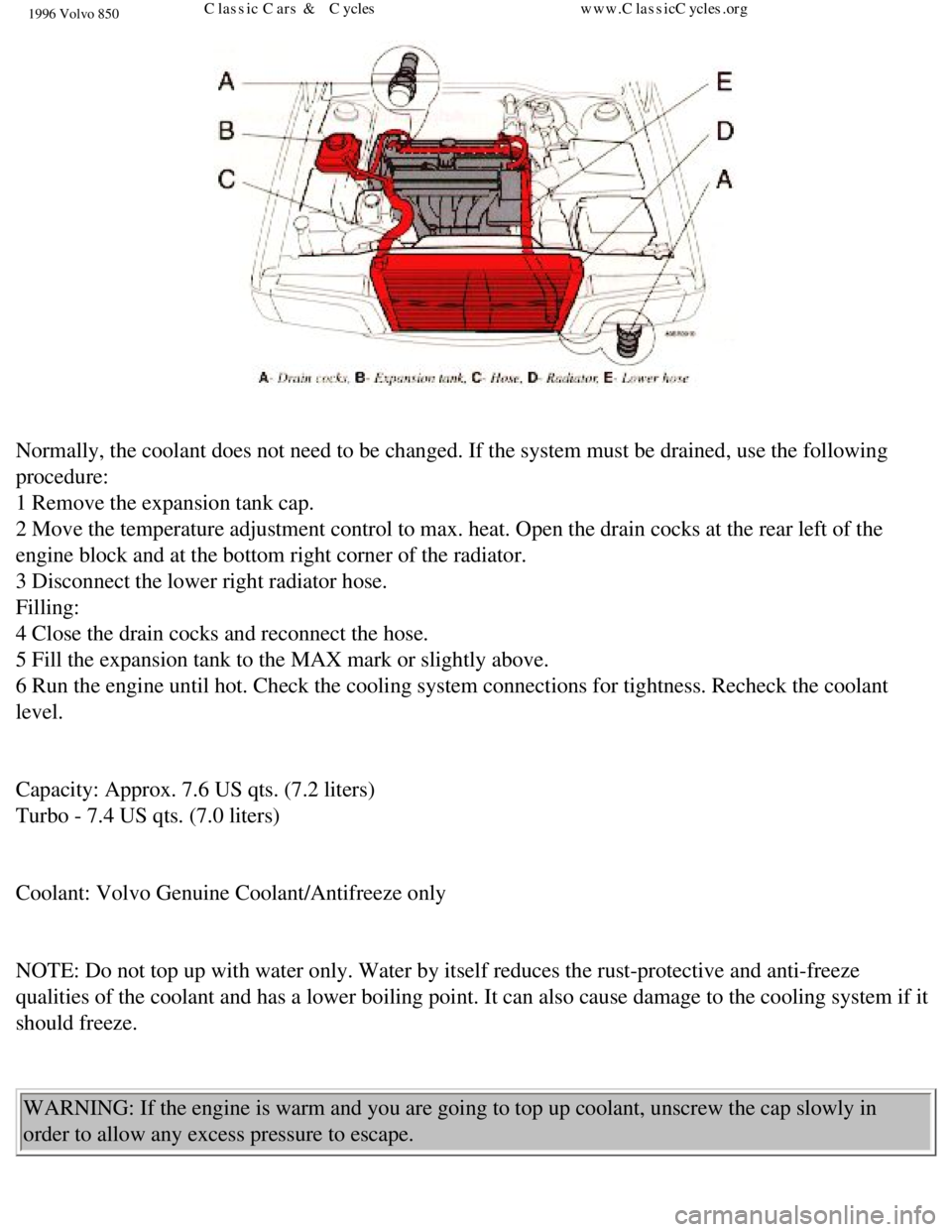
1996 Volvo 850
Normally, the coolant does not need to be changed. If the system must be\
drained, use the following
procedure:
1 Remove the expansion tank cap.
2 Move the temperature adjustment control to max. heat. Open the drain c\
ocks at the rear left of the
engine block and at the bottom right corner of the radiator.
3 Disconnect the lower right radiator hose.
Filling:
4 Close the drain cocks and reconnect the hose.
5 Fill the expansion tank to the MAX mark or slightly above.
6 Run the engine until hot. Check the cooling system connections for tig\
htness. Recheck the coolant
level.
Capacity: Approx. 7.6 US qts. (7.2 liters)
Turbo - 7.4 US qts. (7.0 liters)
Coolant: Volvo Genuine Coolant/Antifreeze only
NOTE: Do not top up with water only. Water by itself reduces the rust-pr\
otective and anti-freeze
qualities of the coolant and has a lower boiling point. It can also caus\
e damage to the cooling system if it
should freeze.
WARNING: If the engine is warm and you are going to top up coolant, unsc\
rew the cap slowly in
order to allow any excess pressure to escape.
file:///K|/ownersdocs/1996/1996_850/96850_813.htm (5 of 7)12/30/2006 9\
:59:53 AMClassic Cars & Cycles www.ClassicCycles.org